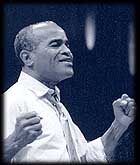
|
|
|
|
|
|
Photo Credit: Tim Owens |
Jon Hendricks
Vocal fireworks are in the house on this edition of Billy Taylor's Jazz at the Kennedy Center. Dr. Taylor welcomes vocalese master Jon Hendricks to the show, saying "he's more than a lyricist, he's a poet." The ebullient Hendricks is one of the more quick-witted and adroit singers in the history of jazz and, with the help of Billy and his trio, he simply enthralls the audience both on and off the bandstand. Hendricks is best known for his ability to write and sing lyrics to instrumental jazz classics and thus transform them into vocal vehicles--a skill known as vocalese. This enduring talent was evident with the pioneering vocal trio Lambert Hendricks & Ross in the early 1950s. Hendricks’ writing and vocal talents neatly survived the breakup of LH&R and his solo exploits and ensemble work with wife Judith, and children Michelle and Aria continue to amaze listeners. Jon's influence on jazz singing spreads far and wide, and encompasses such contemporary stars as Al Jarreau and Bobby McFerrin, as well as vocal ensembles like the Manhattan Transfer, Rare Silk, and New York Voices. Both Jarreau and McFerrin have recorded with Hendricks, and McFerrin actually broke into the business as a member of Jon's family ensemble. Born in Toledo, OH, Jon Hendricks shares a common mentor with Dr. Taylor: jazz piano giant and fellow Toledoan, Art Tatum. Jon tells Billy about his youthful experience with Tatum, revealing that the master loved to hear him sing the pretty melody "Little Man You've Had a Busy Day." Many anecdotes are shared regarding the genesis and life of the legendary Lambert Hendricks & Ross. Jon draws laughter from the audience by relating that when he first met the late Dave Lambert, he went to Dave's house and "He was very laid back.... laid back in those days actually meant tore-up!" The story continues with Jon telling Billy about what turned out to be the first LH&R recording, the now legendary album of Count Basie tunes, "Sing a Song of Basie." It seems Lambert wanted to use a group of singers he knew from television studio work, under the banner The Dave Lambert Singers. According to the ever witty Hendricks, "They sounded like the Moron Tabernacle Choir, who wouldn't have swung if you hung 'em," breaking up the audience once again. One singer did stand out however, a soprano from England named Annie Ross, and the rest is jazz history. To properly finish their now-timeless renditions from the Basie songbook LH&R had to overdub themselves multiple times, painstakingly completing a pioneering multi-tracked recording. Musical selections from this hot edition of the show include "Swingin' Till The Girls Come Home," an apt illustration of Hendricks' peerless scat singing; Horace Silver's "Room 608", which given Jon's original lyrics was re-born as "The Opener." Also included is the timeless blues "Goin' To Chicago," from the Basie songbook. Given Hendricks' superb work as a lyricist, Billy asks him how he manages to keep his lyrics fresh. Jon's lyricism extends to his successful English translation from the original Portuguese lyrics for the hit " Desafinado". He later translated some of the work of the great Brazilian songwriter Antonio Carlos Jobim. One of the high points of Jon Hendricks career came when his musical revue, "The Evolution of the Blues," ran off-Broadway, and at the Monterey Jazz Festival. The latter engagement touched off an extended San Francisco run for the next five years. Our show wouldn't be complete without conversation regarding the revue, and Jon explains the origins of the fundamental blues classic "C.C. Rider," one of the foundation's of " The Evolution of the Blues."
Don't miss Jon Hendricks in our Photo Gallery!
|
|
| |

